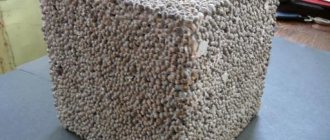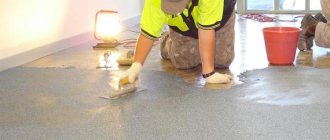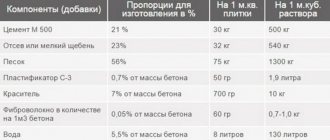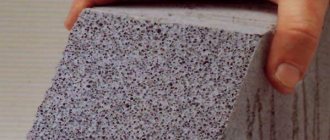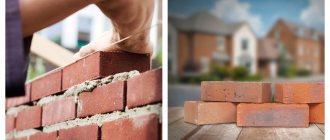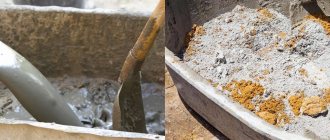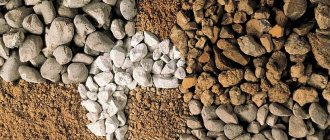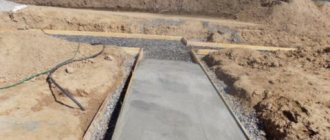Plasticizer for concrete
A plasticizer for concrete mixtures is a chemical additive that is introduced into the solution to improve the physical and chemical characteristics of the building material . As numerous studies show, the use of plasticizing fillers can increase the service life of buildings and structures and improve the quality of structures erected from prefabricated reinforced concrete or monolithic structures.
Adding a plasticizer-filler to concrete helps solve the following problems:
- Improving the properties of the mixture such as fluidity and mobility - due to this, it is possible to minimize the number of voids and improve the characteristics of the monolithic product;
- Increased adhesion of the solution to reinforcing elements;
- Reducing cement consumption during concrete mixing by at least 20%;
- Increasing the life time of the finished solution, which allows you to carry out concrete work on a construction site without haste;
- Increasing resistance to sub-zero temperatures, reducing the freezing rate of the solution;
- Increasing the strength of concrete structures by at least 25% - this becomes possible due to the longer life of the building mixture, which avoids the need to add water during the work process.
Plasticizing filler additives for building mixtures are used in the production of concrete rings, floor slabs, foundations, as well as many other products and structures. There is an expanded range of dry and liquid plasticizers of Russian and foreign production on the market. Depending on the purpose, experts distinguish the following types of fillers:
- Stabilizing concrete aggregates. Their use is advisable for mixtures that are transported over long distances, to prevent concrete delamination on the road.
- Aggregates that increase the rate of hardening of concrete. The additive can reduce the hardening rate of the mixture by 20-25%, which makes it easier to mold parts at subzero temperatures.
- Fillers that reduce the rate of hardening of concrete. Fillers are used if work on a construction site is carried out in several stages and concrete is topped up, which requires ensuring the adhesion of the layers.
- Concrete aggregates that reduce water consumption. This type of plasticizer is needed to reduce the amount of water in the concrete mixture, due to which the strength increases by 20% and the frost resistance of the finished structure increases by 40%.
- Concrete aggregates that increase hydrophobic properties. The purpose of this filler is to remove air bubbles, thereby increasing the strength characteristics of the concrete product.
In addition, today there are highly specialized aggregates . For example, if necessary, you can buy a plasticizer for concrete, which helps increase the stability of the solution to sub-zero temperatures, the destructive effects of ultraviolet rays, regular exposure to moisture and other negative environmental factors.
Depending on the type of concrete filler additive, they differ in the method of application and are accordingly divided into liquid and dry. Liquid plasticizing fillers are concentrated. As a rule, their amount in concrete does not exceed 1%. Proportions may vary depending on the specific product and the desired characteristics of the finished structure. Accordingly, dry plasticizers are presented in the form of a powder, which is added when mixing the solution.
Depending on the origin, fillers are distinguished:
- Organic filler additives - consist only of natural and environmentally friendly components. They are distinguished by their concentration and ability to quickly “give” the desired reaction;
- Inorganic fillers are made from special chemical compounds and polymeric substances that act as catalysts for various reactions.
- Organomineral fillers are a relatively new type of plasticizing fillers, which invariably occupy the top lines of consumer ratings. They are produced from minerals and organic impurities, which makes it possible to obtain safe plasticizing additives that are harmless to people, animals and the environment.
The consumption and choice of plasticizing fillers depends on the form of their release . So, for example, to prepare a solution that will be used for the construction of external walls, interior partitions, and floor screeds, a liquid filler concentrate is added at the rate of 0.5-1 liter of the composition for every 100 kilograms of cement. If we are talking about concrete for constructing a foundation and erecting complex structures, then for every 100 kilograms of cement you will need 1-2 liters of liquid concentrate.
To calculate the required amount of dry powder, you need to clarify the total amount of cement that will be used when mixing the solution and the recommendations of the additive manufacturer.
Mixing the solution in a concrete mixer
Lightweight concrete aggregates
For the production of this type of building material, large aggregates for lightweight concrete GOST 25820-2014 are used, summarized in the table:
| Name of the type of lightweight concrete | Porous aggregates for lightweight concrete | Note |
| Expanded clay concrete | Expanded clay | Artificial lightweight porous material, a product of firing clay or shale |
| Shungizite concrete | Shchungizite | Artificial porous aggregate, a product of firing Precambrian rock - shungite |
| Agloporite concrete | Agloporite crushed stone | Artificial porous material, a product of thermal treatment of coal mining and combustion waste |
| Slag pumice concrete | Slag pumice gravel | Artificial porous material, a product of porousization, cooling and grinding of waste from the metallurgical industry - molten slag |
| Perlite concrete | Perlite crushed stone | Natural porous material of volcanic origin |
| Concrete based on crushed rocks | Volcanic tuff, pumice or volcanic scoria | Natural materials, product of volcanoes |
| Thermolite concrete | Thermolite crushed stone | Artificial porous material, a product of firing and crushing diatomite, tripoli, flask and other siliceous and opal rocks |
| Vermiculite concrete | Expanded vermiculite | Product of heat treatment of natural vermiculite at a temperature of 900-1000 °C |
| Expanded clay-perlite concrete | Expanded clay + sand from expanded vermiculite | |
| Cinder concrete | Waste from coal-fired thermal power plants. Iron production waste | Artificial porous materials – crushed slag |
| Concrete with glassy aggregates | Foam glass | An artificial material obtained by foaming and crushing silicate glass |
Fine aggregate is regulated as: quarry or river sand, as well as artificial sand obtained by fine grinding of rocks and industrial waste.
Aggregates for heavy concrete
When purchasing fillers for concrete, you should be guided by GOST 26633-2012, since they do not reduce density, but rather increase it. The regulatory document provides clear recommendations on this issue:
- The density of coarse filler is 2-3 t/m3.
- The bulk density of fine filler is 2.9 t/m3.
- The following can be used as coarse aggregate for concrete solutions: granite and gravel crushed stone, crushed waste from the metallurgical industry, crushed waste from thermal power plants. The type of coarse aggregate is determined by the product brand and design loads.
- Fine aggregate for concrete and mortars: quarry and river sands, rock grinding product and waste grinding product from the metallurgical industry and thermal power plants.
Important note! To obtain high-quality concrete with a given adhesive strength in all directions of the structure being poured, large aggregates should be used in the form of dosed fractions depending on the largest particle size. The largest particle size and recommended fractions are indicated in the technical documentation for a particular product or structure.
In addition, the grade of crushed stone must correspond to the grade of concrete also specified in the technical documentation. If technical documentation is not available, for the construction of critical structures (foundations, columns, floor slabs) it is recommended to use crushed stone grades M800-M1200, and for lightly loaded non-critical structures (blind areas, paths, platforms) grades M300-M600 or construction waste.
Requirements for concrete aggregates
Occupying an impressive portion of the volume of concrete, aggregates have a great influence on its characteristics. Therefore, certain requirements are imposed on such materials. They are as follows:
- In aggregates (large and small), the ratio of grains of different sizes must fall within certain limits . In other words, any filler must have a certain grain (granulometric) composition. This requirement is determined by the need for maximum saturation of the mortar with aggregate grains. To determine the proportions of grains of different sizes in the material, sieves with cells of different sizes are used. The aggregate under study is divided into fractions. The obtained indicators are compared with the requirements of the standard.
- Any filler for concrete mortar should not have a negative effect on the hardening process of cement or impair the strength and durability of the hardened mixture . To fulfill this requirement, experts determine the degree of strength, frost resistance, resistance to various physical and chemical influences of aggregates, as well as their mineral composition and the characteristics of their grains.
- Aggregates must have a certain degree of purity . Silty, dusty particles envelop the surface of the grains of the material, reducing their ability to adhere to cement. This negatively affects the quality characteristics of concrete. Therefore, the proportion of dust and clay particles in coarse aggregate should not exceed 1%.
Research of aggregates is carried out using the sampling method. During this work, specialists take a certain number of individual samples from the material. The results of the study of these samples are averaged and applied to the entire volume of the aggregate being tested.
Antifreeze filler additives
Antifreeze additives in concrete are various chemical substances that promote hardening of the concrete mixture at subzero air temperatures. Available in the form of liquid concentrate or dry powder. When preparing the solution, the filler involves almost all the liquid in the hardening process of the cement solution, due to which the hydration processes are accelerated. Antifreeze filler additives also ensure that the mixture remains in a liquid state during the cold season.
At air temperatures below +10 degrees Celsius, the reaction that occurs between water and cement becomes more difficult, which is why the hydration process may not begin and, as a result, the mixed mortar will not gain the required strength. As a result, after just a few months of operation of the erected structure, shrinkage cracks will begin to appear on concrete structures, which will gradually lead to their complete destruction. For this reason, the use of PMD filler is advisable when performing seasonal repairs or constructing a new facility in the autumn-winter period.
Attention! When using anti-frost fillers, it should be remembered that at sub-zero air temperatures, the strength of the poured structures will be only 30% of the design strength. The remaining 70% will be gained during thawing. For this reason, masonry made of concrete blocks and monolithic products should not be subjected to increased loads until the onset of summer, otherwise such actions will reduce the frost resistance of structures.
When answering the question why we need PMD filler, it makes sense to note the following advantages obtained from their use:
- Increasing the strength of the monolith by improving the quality of adhesion of the mortar filler;
- Various areas of application of light and heavy concrete, which contain antifreeze additives. In particular, today they are used in industry, in private and commercial construction, etc.
- The use of fillers helps to increase the service life and reliability of buildings;
- Reduce shrinkage of cement mortars and the appearance of cracks, due to increased stabilizing and plasticizing properties of the solution;
- The rate of concrete hardening allows you to independently regulate the pace of construction work;
- Increased moisture resistance of cement structures and no need for additional use of waterproofing agents for interior or exterior decoration;
- Providing additional protection of reinforcing elements from metal corrosion.
Today, manufacturers produce several types of antifreeze filler compositions , which allow you to achieve the desired effect with minimal time and financial costs:
- Antifreeze filler - helps reduce the freezing point of the liquid that is part of the concrete mixture, and reduces the rate of hardening of the finished structure.
- Sulfate-based additives are a popular component for the latest generation of building mixtures. The introduction of this filler into the solution ensures the production of dense material in the shortest possible time. An important feature of sulfate PMD is the active release of heat, which indicates the reaction of concrete with hydration components. Since the specific property of sulfate-based fillers is the formation of high-strength bonds with complexly soluble compounds, their use to lower the pour point of the mixture is not allowed. An example of such an additive would be a chemical modifier.
- Accelerator fillers - their action is based on reactions that increase the solubility of silicates contained in cement, which, when interacting with hydration products, form salts that lower the freezing point of the liquid in concrete.
Attention! The Russian construction market offers a wide range of specialized PMD fillers. For example, you can select a filler that will have a complex effect - regulate the strength gain and adjust the rheological properties of the solution. By reducing the crystallization temperature of the liquid in the mixture, they help reduce the time of primary hardening of concrete, while simultaneously increasing its strength.
The dosage and use of PMD are established by manufacturers in accordance with the current GOST requirements. As a rule, the consumption of additives depends on the following factors:
- The air temperature at which the installation of blocks, tiles, pouring of monolithic structures, etc. will be carried out.
2. Brand strength of cement, which is used for construction work;
- The rate of strength gain of the concrete solution planned by the project;
- Temperature of the mixture at the outlet of the concrete mixer;
- Conditions for maintaining finished structures.
The required amount of fillers is calculated based on the estimated volume of the building mixture (in m3) . If construction is carried out over a long period of time, concrete with added additives must be mixed regularly.
If builders industrially produced antifreeze additives The most common option in this case would be to add chloride salts to the composition of the mixed solution, which can reduce cement consumption, reduce the setting period and reduce the freezing point of the mixture. The only disadvantage of this option can be considered the fact that chlorides activate metal corrosion processes . Therefore, if the structure being built contains metal reinforcing elements, it is best to replace them with other fillers.
Coarse and fine-grained aggregates are important components of concrete that determine the properties of the building material and the characteristics of the finished structures. Therefore, the choice of grain size should be approached with all responsibility, taking into account the goals and objectives facing builders in each specific case.
Carbonate rocks as aggregates and fillers,
Crushed stone is used as a coarse filler in the production of concrete, and for the production of crushed stone, dense carbonate rocks are widely used, which include, for example, marble, limestone, dolomite, etc. About 60% of carbonate rocks are processed into crushed stone, and over time the area their applications continue to expand steadily.
Improved Russian GOSTs now allow various auxiliary components to be added to Portland cement in amounts of up to 5% of the total mass fraction, and up to 20% of limestone can even be added to one type of cement. The production volumes of various dry construction mixtures also continue to increase, and natural carbonate rocks (marble, dolomite, limestone, microcalcite, chalk) and some carbonate materials of synthetic origin are widely used for their production.
Previously, carbonate aggregates such as sand and crushed stone were considered exclusively as inert components in the cement hardening process. However, subsequent researchers turned their attention to the special adhesion strength of cement paste to carbonate rocks. The influence of limestone rocks on the final properties of the resulting cement mortars is, on the one hand, chemical in nature, and on the other, physical in nature. The filler increases the density of the formed cement stone. Limestone used according to domestic standards must contain at least 75% calcium carbonate. Since the initial idea regarding the inertness of limestones was refuted, some negative effects on the durability and strength of hardened cement mortars and concretes may well be attributed to them.
There are two main possible reasons for the occurrence of deformations in carbonate-cement mixtures - the reaction between alkali and carbonate or the formation of a rare mineral thaumasite, the structural formula of which has a destructive effect on cement and concrete as a result of weakening interparticle bonds. The appearance of thaumasite leads to corrosion of concrete, but this problem seems to be relatively little studied so far. Carbonate-alkali corrosion is associated with the introduction of limestone into the concrete composition. The products of the ongoing reactions have a significantly larger volume than that occupied by the original participants in the reaction. In general, the essence of the mechanisms of such corrosion is quite clear, but there are still many ambiguities in this regard.
Elasticity of concrete
Table of initial elastic moduli E (MPa*10-3) in compression and tension of concrete with different performance characteristics:
| Compressive strength classes | B3.5 | AT 5 | B7.5 | AT 10 | B12.5 | B15 | IN 20 | B25 | B30 | B35 | B40 | B45 | B50 | B55 | B60 |
| Characteristics of concrete | |||||||||||||||
| Heavy concrete | |||||||||||||||
| Natural hardening | 9,5 | 13 | 16 | 18 | 21 | 23 | 27 | 30 | 32,5 | 34,5 | 36 | 37,5 | 39 | 39,5 | 40 |
| Heat treatment at atmospheric pressure | 8,5 | 11,5 | 14,5 | 16 | 19 | 20,5 | 24 | 27 | 29 | 31 | 32,5 | 34 | 35 | 35,5 | 36 |
| Autoclave processing | 7 | 10 | 12 | 13,5 | 16 | 17 | 20 | 22,5 | 24,5 | 26 | 27 | 28 | 29 | 29,5 | 30 |
| Fine-grained | |||||||||||||||
| Natural hardening, A-group | 7 | 10 | 13,5 | 15,5 | 17,5 | 19,5 | 22 | 24 | 26 | 27,5 | 28,5 | — | — | — | — |
| Heat treatment at atmospheric pressure | 6,5 | 9 | 12,5 | 14 | 15,5 | 17 | 20 | 21,5 | 23 | — | — | — | — | — | — |
| Natural hardening, B-group | 6,5 | 9 | 12,5 | 14 | 15,5 | 17 | 20 | 21,5 | 23 | — | — | — | — | — | — |
| Autoclave heat treatment | 5,5 | 8 | 11,5 | 13 | 14,5 | 15,5 | 17,5 | 19 | 20,5 | — | — | — | — | — | — |
| Autoclave curing, B-group | — | — | — | — | — | 16,5 | 18 | 19,5 | 21 | 21 | 22 | 23 | 24 | 24,5 | 25 |
| Light and porous | |||||||||||||||
| Medium density grade, D | |||||||||||||||
| 800 | 4,5 | 5,0 | 5,5 | — | — | — | — | — | — | — | — | — | — | — | — |
| 1000 | 5,5 | 6,3 | 7,2 | 8 | 8,4 | — | — | — | — | — | — | — | — | — | — |
| 1200 | 6,7 | 7,6 | 8,7 | 9,5 | 10 | 10,5 | — | — | — | — | — | — | — | — | — |
| 1400 | 7,8 | 8,8 | 10 | 11 | 11,7 | 12,5 | 13,5 | 14,5 | 15,5 | — | — | — | — | — | — |
| 1600 | 9 | 10 | 11,5 | 12,5 | 13,2 | 14 | 15,5 | 16,5 | 17,5 | 18 | — | — | — | — | — |
| 1800 | — | 11,2 | 13 | 14 | 14,7 | 15,5 | 17 | 18,5 | 19,5 | 20,5 | 21 | — | — | — | — |
| 2000 | — | — | 14,5 | 16 | 17 | 18 | 19,5 | 21 | 22 | 23 | 23,5 | — | — | — | — |
| Cellular autoclave curing | |||||||||||||||
| Medium density grade, D | |||||||||||||||
| 700 | 2,9 | — | — | — | — | — | — | — | — | — | — | — | — | — | — |
| 800 | 3,4 | 4 | — | — | — | — | — | — | — | — | — | — | — | — | — |
| 900 | 3,8 | 4,5 | 5,5 | — | — | — | — | — | — | — | — | — | — | — | — |
| 1000 | — | 6 | 7 | — | — | — | — | — | — | — | — | — | — | — | — |
| 1100 | — | 6,8 | 7,9 | 8,3 | 8,6 | — | — | — | — | — | — | — | — | — | — |
| 1200 | — | 8,4 | 8,8 | 9,3 | — | — | — | — | — | — | — | — | — | — | |
Creep of concrete
It is known that the relationship between stress and deformation of concrete is a function of time: a gradual increase in deformation over time is due to creep. Creep of concrete can therefore be defined as the increase in deformation under constant load. Creep deformations can be several times greater than load deformations, so the study and accounting of creep is important in structural mechanics.
On the other hand, if a concrete specimen is subjected to permanent deformation, then creep can be defined as the decrease in stress over time.
To characterize the phenomenon of creep, based on different understandings of the nature of the phenomenon, many terms were used, such as flow, plastic flow, plastic deformation, etc. Currently, the generally accepted term for denoting the growth of deformations over time under constant load is “creep”.
Creep of concrete over time
The role of aggregates in concrete and mortars
These substances perform the following tasks:
- Reduce cement consumption . Such materials occupy a significant part of the volume of concrete mortar, making it more affordable.
- Increases the resistance of hardened concrete to cracking . Cement stone without such additives is more susceptible to splitting due to its tendency to shrink and deform. Modern aggregates play the role of a rigid skeleton of concrete, reducing its shrinkage several times compared to the shrinkage of cement without such additives.
- They increase the strength of hardened concrete mortar and improve the elastic modulus of concrete. A rigid skeleton made of aggregate minimizes deformation of the structure under load and reduces the creep of concrete. In this way, after hardening, the concrete solution is protected from the occurrence of irreversible plastic deformations of various types.
- Porous, lightweight aggregates reduce the thermal conductivity and density of concrete . Thanks to this, such a solution can be used to create enclosing or thermal insulation structures.
- Special hydrated and especially heavy fillers make concrete structures resistant to penetrating radiation .
